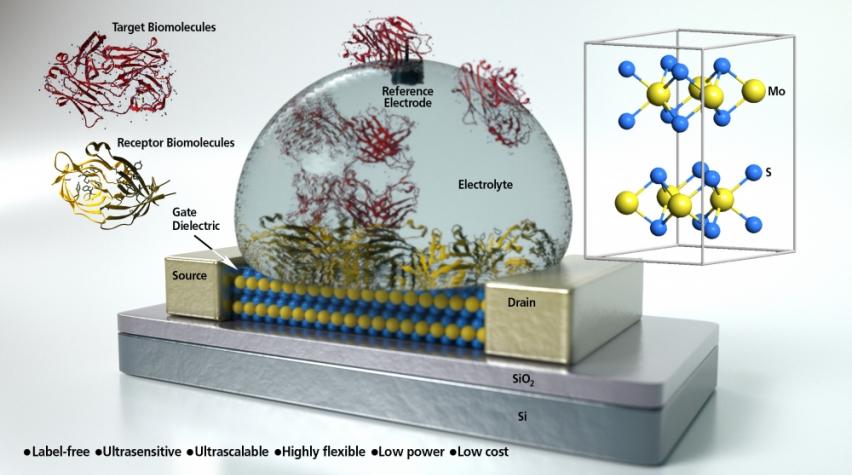
Graphene has serious competition, according to researchers at the University of California at Santa Barbara, who are using molybdenum disulfide or molybdenite (MoS2) as an ultrasensitive semiconductor material for biosensing. The new technology promises to push the boundaries of biosensing technology in many fields, from health care to environmental protection to forensic industries. When molybdenite, commonly used as a dry lubricant, is used as a biosensor material it surpasses graphene's already high sensitivity, offers better scalability and lends itself to high-volume manufacturing. Results of the researchers' study were recently published in ACS Nano.
Why molybdenite beats graphene
The key, according to UCSB professor of electrical and computer engineering Kaustav Banerjee, who led this research, is MoS2's band gap, the characteristic of a material that determines its electrical conductivity. Semiconductor materials have a small but nonzero band gap and can be switched between conductive and insulated states controllably. The larger the band gap, the better its ability to switch states and to insulate leakage current in an insulated state. MoS2's wide band gap allows current to travel but also prevents leakage and results in more sensitive and accurate readings.
While graphene has shown strong potential for use as a biosensor due to a variety of properties - such as its two-dimensional nature that allows excellent electrostatic control of the transistor channel by the gate, and high surface-to-volume ratio - the sensitivity of a graphene field-effect transistor (FET) biosensor is fundamentally restricted by its zero band gap, which results in increased leakage current, leading to reduced sensitivity, according to researchers at the Nanoelectronics Research Lab at UCSB. Banerjee explained molybdenite's main advantage over graphene in a press release as follows:
Monolayer or few-layer MoS2 have a key advantage over graphene for designing an FET biosensor: They have a relatively large and uniform band gap (1.2-1.8 eV, depending on the number of layers) that significantly reduces the leakage current and increases the abruptness of the turn-on behavior of the FETs, thereby increasing the sensitivity of the biosensor.
Molybdenite has also shown strong potential in other areas, such as in the production of cheaper hydrogen, which ChEnected covered earlier this year (Thin-Film Catalyst Promises Cheaper Hydrogen Production). To learn more about the research into using molybdenite as a biosensor, see more in this report from UC Santa Barbara.


